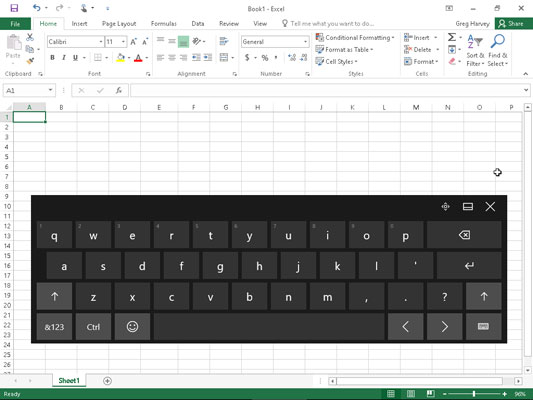If you're running Excel 2016 on a touchscreen device that lacks any kind of physical keyboard, such as a Surface 3 tablet without the optional Type Cover, you need to open the Touch keyboard and use it to input your spreadsheet data.
To open the Touch keyboard, simply tap the Touch Keyboard button that appears on the right side of the Windows 7,8, or 10 taskbar. Doing this displays the Touch keyboard docked at the bottom of the Excel program window.
To undock the Touch keyboard beneath the Excel 2016 program window, click the Dock/Undock button that appears to the immediate left of the Close button in the upper-right corner of the keyboard. The figure shows you how your touchscreen looks after undocking the Windows 10 Touch keyboard and dragging it up away from the Excel status bar.

As shown in this figure, when undocked, the Windows 10 Touch keyboard remains completely separate from the Excel program window so that you can reposition it so that you still have access to most of the cells in the current worksheet when doing your data entry. The Windows 10 Touch keyboard is limited mostly to letter keys above a spacebar with a few punctuation symbols (apostrophe, comma, period, and question mark). This keyboard also sports the following special keys:
Backspace key (marked with the x in the shape pointing left) to delete characters to the immediate left when entering or editing a cell entry
Enter key (with the bent arrow) to complete an entry in the current cell and move the cursor down one row in the same column
Shift keys (with arrows pointing upward) to enter capital letters in a cell entry
Numeric key (with &123) to switch to the Touch keyboard so that it displays a numeric keyboard with a Tab key and extensive punctuation used in entering numeric data in a cell (tap the &123 key a second time to return to the standard QWERTY letter arrangement)
Ctrl key to run macros to which you've assigned letter keys or to combine with the left arrow or right arrow key to jump the cursor to the cell in the last and first column of the current row, respectively
Emoticon key (with that awful smiley face icon) to switch to a bunch of emoticons that you can enter into a cell entry (tap the Emoticon key a second time to return to standard QWERTY letter arrangement)
Left arrow (with the
Right arrow (with the > symbol) to move the cell cursor one cell to the immediate left and complete any cell entry in progress
When you finish entering your worksheet data with your Windows Touch keyboard, you can close it and return to the normal full screen view of the Excel program window by tapping the Close button.
The Windows Touch keyboard supports a split-keyboard arrangement that enables you to see more of the cells in your worksheet as you enter your text and numbers in the worksheet from separated banks of keys on the left and right side of the worksheet area. To switch to this arrangement, tap the Keyboard button in the very lower-right corner of the Touch keyboard and then tap the second-from-the-left icon with the picture of a keyboard with space in the middle from the pop-up menu that appears.
Excel then displays the split-Touch keyboard with a version of the ten-key keypad in the middle of the keyboard and the QWERTY letter keys separated into a left and right bank. You can also switch to an Inking keyboard (the icon second from the right with a stylus sticking out of it) where you can make cell entries by writing your entries in the keyboard area with your stylus and then inserting them into the worksheet by tapping its Insert button.





